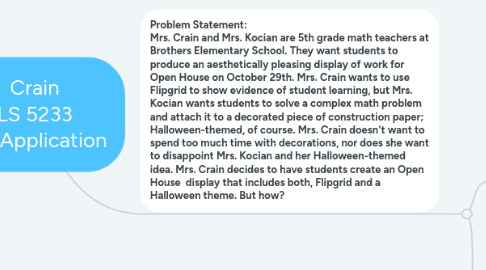
1. References: Future Ready Schools. (2018). Future Ready Librarian factsheet. Retrieved from http://1gu04j2l2i9n1b0wor2zmgua.wpengine.netdna-cdn.com/wp-content/uploads/2017/01/Library_flyer_download.pdf Google Computational Thinking for Educators. (n.d.). What is computational thinking? Retrieved from https://computationalthinkingcourse.withgoogle.com/unit
2. Problem Statement: Mrs. Crain and Mrs. Kocian are 5th grade math teachers at Brothers Elementary School. They want students to produce an aesthetically pleasing display of work for Open House on October 29th. Mrs. Crain wants to use Flipgrid to show evidence of student learning, but Mrs. Kocian wants students to solve a complex math problem and attach it to a decorated piece of construction paper; Halloween-themed, of course. Mrs. Crain doesn't want to spend too much time with decorations, nor does she want to disappoint Mrs. Kocian and her Halloween-themed idea. Mrs. Crain decides to have students create an Open House display that includes both, Flipgrid and a Halloween theme. But how?
2.1. Decomposition: First, Mrs Crain has to break down the overall problem into smaller, manageable parts. In this case, Mrs. Crain needs to find problems that would work well for both Flipgrid discussion and Halloween decorations, searching for math problems that are both complex and easily illustrated to create a display that will appease all. So she logs into her Lead4ward, Pinterest, and Teachers Pay Teachers accounts; and searches for both on-level complex problems, and Halloween-themed math ideas.
2.1.1. Pattern Recognition: As Mrs. Crain searches for different complex problems and Halloween themed ideas, she notices patterns. Complex 5th grade math problems were mostly multi-step problems, simplifying expressions, and multiplying and dividing positive rational numbers. Halloween-themed math ideas typically included the use of jack-o-lanterns, witches, ghosts, bats, and candy. There are, of course, varied ideas and problems to choose from, but these are the common patterns she finds. Mrs. Crain also notices that complex math problems often include labeled steps to indicate method for solving, or justification of correctness (either explained or written).
2.1.1.1. Algorithm: Mrs. Crain creates a Halloween-themed math project with step-by-step instructions for successful completion, using a combination of Flipgrid and Halloween whimsy. She then assigns the project to her students, with ample time to complete, after giving a thorough explanation and providing an example to refer to. Students use the order of operations to simplify different expressions like: [(7*2)-3]+8/2*3. The entire process is recorded in an upside down candy corn, so that each step taken is demonstrated in a layer of the candy corn. Students then dress up in their Halloween costumes and use Flipgrid to share their completed work, explain steps taken, and give justifications for their answers.
2.1.1.1.1. Abstraction: Mrs. Crain realizes that it is possible to combine other seasonal events, technology applications, and math content to create engaging math assignments and assessments to show evidence of learning. For example, around Thanksgiving time, she could have students solve complex word problems and use their papers as triggers for HP Reveal, an augmented reality application, so that parents and peers can hover over their paper, with an ipad and see a short video of them giving thanks to the operations that were necessary to solve the problem. For Christmas, she could have students complete prime factorization for different numbers using the tree factor method; then have them draw and decorate an outline of a Christmas tree around their work, and upload it to SeeSaw with an ipad. The possibilities are endless! Perhaps one day she will become a school librarian, builds some instructional partnerships, and help implement the active use of technology in the classroom (Future Ready Schools, 2018).
2.2. Rationale: This scenario is an example of the decomposition element of computational thinking because it breaks down the Open House conundrum into smaller, manageable parts. (Google Computational Thinking for Educators, n.d.)
2.2.1. Rationale: This scenario is an example of the pattern recognition element of computational thinking because it shows the observable patterns, trends, and regularities in the data that can be found when searching for 5th grade math problems and Halloween ideas. (Google Computational Thinking for Educators, n.d.)
2.2.1.1. Rationale: This scenario is an example of the algorithm element of computational thinking because it demonstrates the step by step instructions Mrs. Crain utilized for solving this problem (Google Computational Thinking for Educators, n.d.)
2.2.1.1.1. Rationale: This scenario is an example of the abstraction element of computational thinking because it clearly identifies the general principles for incorporating real-world occurrences, curriculum, and technology into instruction. It also provides insights for future lesson planning. (Google Computational Thinking for Educators, n.d.)

